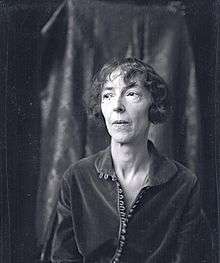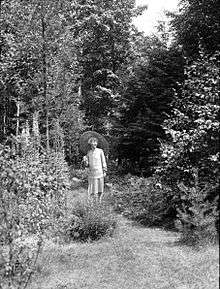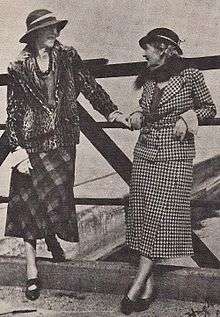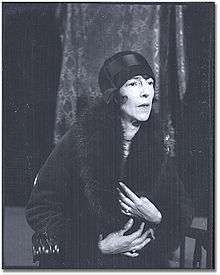Mazo de la Roche
| Mazo de la Roche | |
|---|---|
 Mazo de la Roche, December 18, 1927 | |
| Born |
Mazo Louise Roche January 15, 1879 Newmarket, Ontario |
| Died |
July 12, 1961 (aged 82) Toronto, Ontario |
| Nationality | Canadian |
| Partner(s) | Caroline Clement |
| Parent(s) |
|
Mazo de la Roche (January 15, 1879 – July 12, 1961), born Mazo Louise Roche in Newmarket, Ontario, Canada, was the author of the Jalna novels, one of the most popular series of books of her time.
Biography
Early life

Mazo Louise Roche was the only child of William Roche, a salesman, and Alberta (Lundy) Roche, who was a great-great-niece of David Willson, founder of the Children of Peace, through the latter's elder half-brother Hugh L. Willson.[1] On her father's side of the family, Mazo's uncle Francis signed himself as "Francis J. de la Roche", claiming a descendancy from Sir Richard de la Roche (1199-1283) of Strongbow's army;[2] Mazo eventually adopted the "de la Roche" surname as her own as well.
Mazo was born in Newmarket, Ontario, north of Toronto. The family moved frequently throughout Southern Ontario during her childhood because of her mother's ill health and her father's many jobs; de la Roche lived successively in Newmarket (1879–85), at least two separate addresses in Toronto (1885–88), several dwellings in Orillia (1888–91), Galt (1891-92), Orillia (again, 1892–94) and Toronto (again, 1894-1900).[3][2] She was a lonely child who became an avid reader and developed her own fictional world, "The Play," in which she created imaginary scenes and characters. One of the family's moves meant some years on a farm owned by a wealthy man who farmed as a hobby. There de la Roche began to develop her fictional world of rural aristocracy that would—years later—become Jalna.
When de la Roche was seven, her parents adopted her orphaned eight-year-old cousin Caroline Clement, who joined in Mazo's fantasy world game and would become her lifelong companion. De la Roche wrote her first (unpublished) short story at age 9. She attended high school at Jameson Collegiate (now Parkdale Collegiate Institute) in west end Toronto, and later studied at the Metropolitan School of Music, the University of Toronto, and the Ontario School of Art, all in Toronto.[3]
Early writing career
De la Roche, then 23, had her first story published in 1902 in Munsey's Magazine, but very shortly thereafter (in February 1903) she suffered a mental breakdown. For the next several years, de la Roche suffered from depression and insomnia, and did not write.
In 1905, Mazo and Caroline moved with Mazo's parents to Acton, Ontario to operate the Acton House hotel.[4] She was known locally as "Maisie Roach",[5] and lived there until 1908, selling one of her stories while she was there.[6] Her novel Delight was based on her time there,[4] and Acton's geography figures notably in Possession.[5] A few years later in 1911, by now in her early thirties, Mazo moved with Caroline and the Roches to Sovereign House in Bronte, Ontario, to try life as farm owners. By now, de la Roche had resumed writing and was placing stories in American magazines on an occasional basis.
William Roche, Mazo's father, died in 1915[7] of cirrhosis of the liver brought on by alcoholism. Mazo, Caroline, and Mazo's sickly mother Alberta moved back to Toronto.
De la Roche continued to write, but at this juncture Caroline Clement was the main breadwinner of the household, working as a civil service clerk. (She would eventually rise to become the province of Ontario's chief statistician.) During the summers, Clement lived in a Toronto boarding house while de la Roche and her mother would stay in a cottage near Lake Simcoe, several hours north of the city.
Alberta Roche died in 1920. After this, de la Roche's writing career began in earnest, and Clement and de la Roche were never again separated for any significant length of time. During most of the 1920s, they split their time between Toronto and a cottage they had built in Clarkson, Ontario.
Mazo de la Roche's first published book, Explorers of the Dawn, appeared in 1922, and was a fix-up of some previously published sketches, vignettes and stories rewritten to work within an overarching narrative framework. Her first two proper novels, Possession (1923) and Delight (1926), were romantic novels which were mild successes, but nevertheless earned her little in income or recognition. de la Roche also wrote plays and short stories through this period.
Her third novel, Jalna, was submitted to the American magazine Atlantic Monthly, winning a $10,000 award. Its victory and subsequent publication in 1927 brought de la Roche fame and fortune at the age of 48.

Jalna series
Jalna was an immediate sensation, with the public demanding sequels and prequels for the rest of de la Roche's life. Though she would continue to write other works, the series known as the Jalna series or the Whiteoak Chronicles would dominate the rest of her writing career. The series tells the story of one hundred years of the Whiteoak family covering from 1854 to 1954. The 16 "Jalna" novels were not written in sequential order, however, and each can be read as an independent story.
There are similarities and differences in the experiences of the Whiteoak family and that of de la Roche. While the lives and successes of the Whiteoaks rise and fall, there remained for them the steadiness of the family manor, known as Jalna. De la Roche's family endured the illness of her mother, the perpetual job searches of her father, and the adoption of her orphaned cousin while being moved 17 times. Several critics believe that Finch Whiteoak who majors in Finch's Fortune (1932) is a reflection of de la Roche herself. He was a somewhat tortured concert pianist with overtones of gayness.[8] The names of many of the characters were taken from gravestones in a Newmarket, Ontario cemetery.
Bestselling author
The sudden bout of fame was not an immediate blessing for de la Roche, as the stress of the attendant publicity caused her to experience another breakdown in early 1928.[9] She eventually recovered, and began writing a sequel to Jalna, which was published in 1929.
The income from Jalna and its sequels allowed de la Roche to become the main breadwinner of the household, after years of having been supported by Clement. The two would make an extended trip to Europe beginning in 1929, living first in Italy, then in the United Kingdom. In 1931 they adopted the two orphaned children of friends of theirs.[10] This was extremely unusual for the time, as adoptions by single women were technically not allowed in the UK during this era; the machinations by which de la Roche and Clement were able to do this are unknown.
The family returned to Toronto for a time in 1934-35, heading back to England again in 1936 before returning to Toronto for good in 1939. During this era, de la Roche reliably published at least one book a year, sometimes more. However, although her early work had received positive critical notices, critical reaction to her newer works was often decidedly cool, in both North America and Europe.[2] Nevertheless, the Jalna books were still strong sellers, with a wide and appreciative readership.
de la Roche's productivity slowed somewhat once she was in her sixties and seventies. Partly due to arthritis in her hands, much of her later work was dictated to Clement. She still published regularly right up to her death, with her final novel Morning at Jalna appearing in 1960 when she was 81.
Mazo and Caroline Clement
Overall, Mazo de la Roche and Caroline Clement lived a fairly reclusive life, and their relationship was not discussed widely in the press. In her infrequent interviews, de la Roche often expressed a need for privacy. Though there has been much speculation in recent years as to the exact nature of the relationship between de la Roche and Clement, de la Roche's autobiography makes no mention of them being anything other than close companions.
Not long after de la Roche’s death in 1961, in accordance with her wishes Clement burned almost all of the author’s personal diaries. Clement died in 1972.
Most recently, de la Roche was the subject of a Red Queen Productions and National Film Board of Canada co-production, The Mystery of Mazo de la Roche, which premiered on March 17, 2012 at the Festival international du film sur l'art in Montreal, then had its Toronto Premiere at Hot Docs April 29/12. The film is directed by Maya Gallus, produced by Justine Pimlott & Anita Lee, and combines archival material with dramatic reenactments featuring Severn Thompson as Mazo de la Roche.[11] The film "lend(s) credence to the theory that its subject was a closeted lesbian",[12] although several people in the film who knew de la Roche and Clement, including their adopted daughter Esmée, state on-camera that they believe the relationship between the two was close but ultimately platonic.
Death and legacy
Mazo de la Roche is buried near the grave of Stephen Leacock at St. George's Anglican Church, at Sibbald Point, near Sutton, Ontario. Later, Caroline Clement was buried alongside her.

The Jalna series has sold more than eleven million copies in 193 English and 92 foreign editions. In 1935, the film Jalna, based on the novel, was released by RKO Radio Pictures and, in 1972, a CBC television series was produced based on the series.
Benares in Clarkson, Ontario is believed to be the inspiration for Jalna[13] (Benares and Jalna are in fact both names of Indian cities) and is now maintained by the Museums of Mississauga.[14] A nearby park is named Whiteoaks in honour of the series, as is a nearby elementary school. Streets in the area also bear names such as "Mazo Crescent," "Jalna Avenue," and "Whiteoaks Avenue."
Her house at 3590 Bayview Avenue in Toronto, Ontario, bought by The Zoroastrian Society of Ontario in 1975, currently (2007) serves as its community centre. It is listed as a City of Toronto Heritage Property.[15]
In the 1970s, a land developer in London, Ontario used the characters from de la Roche's Jalna series to name streets for a new subdivision named White Oaks. Streetnames used from the Jalna series include: Jalna Boulevard, Ernest Avenue, Renny Crescent, Finch Crescent, Nicholas Crescent, Alayne Crescent, Archer Crescent, Piers Crescent, Meg Drive.[16]
In 1990, a new French-immersion public school in de la Roche's birthplace of Newmarket, Ontario was named in her honour.
Responding to an enquiry on the pronunciation of her name, her secretary told The Literary Digest: "Her Christian name is pronounced may'zo, and Roche is pronounced rosh, to rhyme with Foch."[17]
Works
Novels
| Year | Title | Publisher | Series | (Order) | Notes |
|---|---|---|---|---|---|
| 1922 | Explorers Of The Dawn | Knopf | |||
| 1923 | Possession | Macmillan | Reprinted, C. Chivers, 1973. | ||
| 1926 | Delight | Macmillan | Reprinted with introduction by Desmond Pacey, McClelland and Stewart, 1961 | ||
| 1927 | Jalna | Little, Brown | Jalna | 7 | ISBN 0-316-18000-9 |
| 1929 | Whiteoaks of Jalna | Little, Brown | Jalna | 8 | Also published as Whiteoaks, Macmillan, 1929; ISBN 0-316-18014-9 |
| 1930 | Portrait of a Dog | Little, Brown | |||
| 1932 | Finch's Fortune | Little, Brown | Jalna | 9 | ISBN 0-333-09966-4 |
| 1932 | Lark Ascending | Little, Brown | |||
| 1932 | The Thunder of the New Wings | Little, Brown | |||
| 1933 | The Master of Jalna | Little, Brown | Jalna | 10 | ISBN 0-316-18002-5 |
| 1934 | Beside a Norman Tower | Little, Brown | |||
| 1935 | Young Renny | Little, Brown | Jalna | 4 | ISBN 0-333-01371-9 |
| 1936 | Whiteoak Harvest | Little, Brown | Jalna | 11 | ISBN 0-333-07404-1 |
| 1937 | The Very Little House | Little, Brown | |||
| 1938 | Growth of a Man | Little, Brown | |||
| 1940 | Whiteoak Heritage | Little, Brown | Jalna | 5 | ISBN 0-333-05090-8 |
| 1941 | Wakefield's Course | Little, Brown | Jalna | 12 | ISBN 0-316-18010-6 |
| 1942 | The Two Saplings | Macmillan | |||
| 1944 | Building of Jalna | Little, Brown | Jalna | 1 | ISBN 0-316-17996-5 |
| 1946 | Return to Jalna | Little, Brown | Jalna | 13 | ISBN 0-333-04842-3 |
| 1949 | Mary Wakefield | Little, Brown | Jalna | 3 | ISBN 0-333-07652-4 |
| 1951 | Renny's Daughter | Little, Brown | Jalna | 14 | ISBN 0-333-08561-2 |
| 1953 | Whiteoak Brothers | Little, Brown | Jalna | 6 | ISBN 0-333-08809-3 |
| 1954 | Variable Winds at Jalna | Little, Brown | Jalna | 15 | ISBN 0-333-02280-7 |
| 1955 | The Song of Lambert | Macmillan | Juvenile | ||
| 1958 | Centenary at Jalna | Little, Brown | Jalna | 16 | ISBN 0-316-17997-3 |
| 1958 | Bill and Coo | Macmillan | Juvenile | ||
| 1960 | Morning at Jalna | Little, Brown | Jalna | 2 | ISBN 0-333-03933-5 |
Plays
- Low Life: A Comedy in One Act (first produced as Low Life in Toronto, Ontario, at Trinity Memorial Hall, May 14, 1925), Macmillan, 1925.
- Come True (first produced in Toronto at Trinity Memorial Hall, May 16, 1927), Macmillan, 1927.
- The Return of the Emigrant (first produced in Toronto at Trinity Memorial Hall, March 12, 1928.) Collected in Low Life and Other Plays (contains Low Life, Come True, and The Return of the Emigrant), Little, Brown, 1929. ISBN 1-131-68067-7
- (With Nancy Price) Whiteoaks: A Play (adapted from Whiteoaks of Jalna; first produced in London, England, at Little Theatre in the Adelphi, April 13, 1936; produced on Broadway, 1938), Macmillan, 1936. ISBN 0-333-06247-7

Short story collections
Non-fiction
- Quebec: Historic Seaport (non-fiction), Doubleday, 1944. ISBN 1-121-26423-9
- Ringing the Changes: An Autobiography, Little, Brown, 1957. ISBN 1-141-37942-2
- (Author of introduction) George F. Nelson, editor, Northern Lights: A New Collection of Distinguished Writing by Canadian Authors, Doubleday, 1960. OCLC 1395116, LCCN 60-9741.
Related works
See also
References
- ↑ "The Willson Family" (PDF). www.sharontemple.ca. Archived from the original (PDF) on April 11, 2013. Retrieved September 25, 2013.
- 1 2 3 de la Roche, Mazo (1957). Ringing the Changes. Dundurn Press.
- 1 2 "Mazo de la Roche". Simon Fraser University. 2014.
- 1 2 Coles, Hartley (January 8, 1997). "Why the omission?". Acton Tanner. p. 6.
- 1 2 Coles, Hartley (July 19, 2007). "Acton knew her as plain Maisie Roach; worldwide she was Mazo de la Roche". New Tanner. Acton.
- ↑ "Mazo de la Roche Here a Year; Father Ran Main St. Hotel". The Acton Free Press. July 20, 1961. p. 1.
- ↑ "Died: Roche". The Acton Free Press. July 8, 1915. p. 2.
- ↑ p. 37, Not in Front of the Audience by Nicholas de Jongh
- ↑ Plummer, Kevin (June 28, 2014). "Historicist: Revealing Fictions". Torontoist.
- ↑ "Mazo de la Roche". AndrejKoymasky.com. Archived from the original (– Scholar search) on October 17, 2007. Retrieved 2007-10-26.
- ↑ Weldon, Carolyne (16 March 2012). "Feature film on Canada's most famous unknown author premieres at FIFA". NFB.ca Blog. National Film Board of Canada. Retrieved 31 March 2012.
- ↑ Carrington, Julian (April 23, 2012). "The Mystery of Mazo de la Roche". Torontoist.
- ↑ Benares Historic House
- ↑ Museums of Mississauga
- ↑ "City of Toronto's Inventory of Heritage Properties". Archived from the original on 2007-09-27.
- ↑ "Google Map of White Oaks".
- ↑ Charles Earle Funk, What's the Name, Please?, Funk & Wagnalls, 1936.
Further reading
- Petri Liukkonen. "Mazo de la Roche". Books and Writers
- Virginia Careless Mazo De La Roche: Mistress of Jalna 1879-1961. Retrieved June 23, 2005. Archive of article at the Wayback Machine (archived June 3, 2006)
- Mazo de la Roche Public School (2004). History - Mazo de la Roche (1879-1961). Retrieved June 23, 2005.
- The Columbia Encyclopedia, Sixth Edition (2004). de la Roche, Mazo. Retrieved June 23, 2005.
- Ontario Museum Association (2005). Benares Historic House. Retrieved June 23, 2005.
- James H. Marsh, ed. (1990). The Junior Encyclopedia of Canada. Edmonton: Hurtig Publishers Ltd.. ISBN 0-88830-334-3.
- Ellie Friedman & Joyce Y. Carter (1995). The Jalna Series; or, The Whiteoak Chronicles by Mazo de la Roche. Retrieved June 26, 2005.
- "Biography - de la Roche, Mazo (1879-1961)" (2004). Contemporary Authors. Thomson Gale.
- D. M. Daymond (1976). "Nature, Culture and Love: Mazo De La Roche's Explorers of the Dawn and The Thunder of New Wings". Studies in Canadian Literature, 1.2.
- Joan Doig (1980). "Mazo de la Roche's Delight: An Unexpected Source". Studies in Canadian Literature, 5.2.
External links
- Mazo de la Roche's entry in The Canadian Encyclopedia
- Google map of Benares Historic House
- Ontario Plaques - Mazo de la Roche
Electronic archives
- Works by Mazo De la Roche at Project Gutenberg
- Works by Mazo de la Roche at Faded Page (Canada)
- Works by Mazo de la Roche at LibriVox (public domain audiobooks)

- Works by or about Mazo de la Roche at Internet Archive